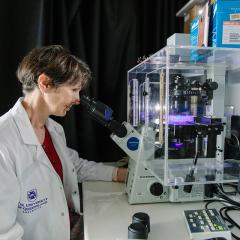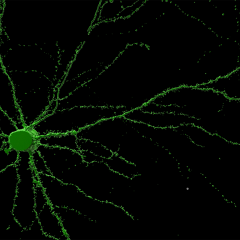We are a step closer to understanding how our brain interprets the visual world, thanks to research at The University of Queensland’s Queensland Brain Institute (QBI).
By using refined electrical recording techniques, researchers have studied how nerve cells in a rabbit’s eye respond differently to patterns of visual stimuli.

Professor Stephen Williams said the research team had discovered how two related classes of ganglion cells – the final output neurons of the retina – share the task of processing, coding, and conveying visual information to the brain.
“A rabbit’s sustained ganglion cells have incredibly active dendrites -- the branch-like extensions that conduct electrical signals toward the cell body,” he said.
“This allows sustained ganglion cells to react exquisitely to the motion of visual objects – allowing, for example, the detection of a bird of prey hundreds of metres from the rabbit.
“In contrast, we found that transient ganglion cells have electrically inactive dendrites, and so these cells cannot respond to small moving objects. Surprisingly however, transient cells respond when a large visual object looms towards the rabbit’s eye – such as when an eagle swoops to make a final attack.
“Importantly we find that through the rich, cell-class-specific expression of the electrical activity of dendrites, ganglion cells execute computations important for an animal’s survival, working in tandem to convey salient visual information to the higher brain.
“The way the rabbit’s retinal circuitry achieves these computations is both energy and anatomically efficient, through the tiling of ganglion cells across the retinal surface.
“These computations are made not just at one point in visual space, but at all points across the field of vision, allowing sustained ganglion cells to convey an uninterrupted code of information to the brain about where the eagle is.”
As the retinal circuit is similar across mammals, the next step for the researchers is to test these findings in people.
Professor Williams said biological discoveries like this also have wider implications, for example, in the development of artificial intelligence.
“Modern algorithms are beginning to use these biological principles to create more efficient, robust computing systems,” he said.
This research builds on previous research showing dendrites have powerful processing capabilities integral to how neuronal circuits in the brain process information.
Their latest study was published in Neuron (10.1016/j.neuron.2022.06.009) as “Light-evoked dendritic spikes in sustained but not transient rabbit retinal ganglion cells.”
Media: QBI Communications, communications@qbi.uq.edu.a, Elaine Pye +61 (0)415 222 606, Merrett Pye +61 (0)422 096 049.



